Fashion
Garments by Ryunosuke Okazai
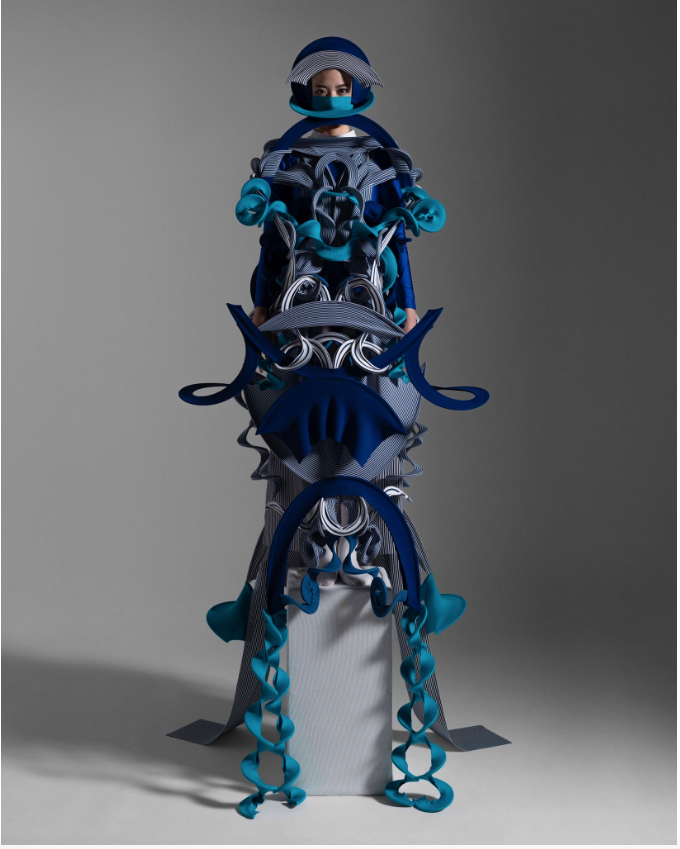
More pix here.
The creator's homepage.
Posted By: Paul - Mon Mar 29, 2021 -
Comments (1)
Category: Aliens, Excess, Overkill, Hyperbole and Too Much Is Not Enough, Fashion, Asia
Clothes Form
Butler Baker invented a "clothes form" to prevent clothes from sticking to a person's body in hot weather. It consisted of a scaffolding of wire rings to be worn beneath a person's clothes.In his 1927 patent, Baker asserted that these rings would "maintain clothing spaced from the body of the wearer at all times, thereby overcoming the disagreeable feature of the clothing sticking to the body during warm weather." Furthermore, "the device is simple in construction, light, and constructed in a manner whereby it will not interfere with the bending of the body."
It would be even better if it somehow had a fan at the bottom blowing air over your body. You might look weird wearing it, but at least you'd be cool.

Posted By: Alex - Sun Mar 21, 2021 -
Comments (7)
Category: Fashion, Underwear, Patents, 1920s
The Blanc Mask
A new face mask that not only filters air but also prevents facial recognition.More info: blancmasks.com, gizmodo


Posted By: Alex - Mon Feb 22, 2021 -
Comments (6)
Category: Fashion, Health
Bathing Poncho
The bathing poncho, invented by Timothy and Brenda Reardon, allows someone to shower while clothed. From the patent:In institutions such as hospitals, nursing homes, college dormitories, gyms, and the like, the bathing or showering facilities often lack the privacy to which one is accustomed to at home. Thus, becoming unclad to take a shower or a bath can be somewhat of an unpleasant and embarrassing experience. A covering that would preserve one's dignity by minimizing exposure while also insuring a thorough cleansing would certainly be a welcome addition in the marketplace.
I can appreciate the problem this addresses, but I wouldn't want to be the kid who shows up in the locker room shower wearing one of these.
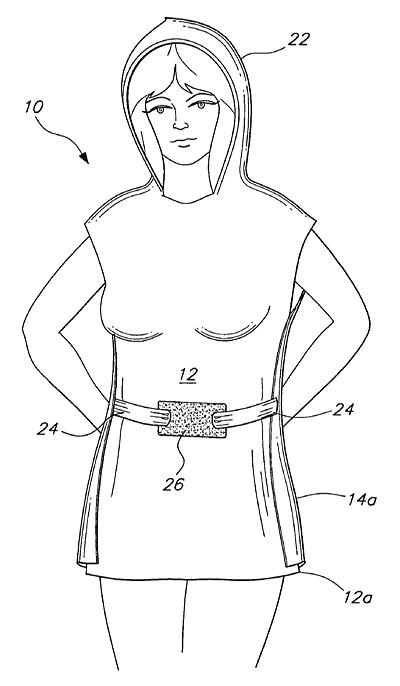
Posted By: Alex - Sun Feb 07, 2021 -
Comments (3)
Category: Fashion, Hygiene, Baths, Showers and Other Cleansing Methods, Inventions, Patents
Wearable buildings
New from Louis Vuitton for its Fall 2021 menswear collection: 3D Skyline Puffer Jackets.At least they look warm. So not entirely impractical.
More info: today.com


Posted By: Alex - Wed Feb 03, 2021 -
Comments (5)
Category: Fashion
The Newbury Coat
1811: Sir John Throckmorton bet one thousand guineas that a woolen coat could be made in its entirety, starting with the shearing of the sheep, between sunrise and sunset. He believed that the wool could be "A Sheep's Coat at Sunrise, A Man's Coat at Sunset." The experiment took place on June 25, 1811, in the town of Newbury, England, and Throckmorton won his bet.The 'Newbury Coat' maintained the record for the fastest coat ever made until Sep 21, 1991, when an identical coat was made, in the same manner, but an hour faster.
More details: Berkshire History

Liverpool Mercury - July 26, 1811

Posted By: Alex - Sun Jan 24, 2021 -
Comments (2)
Category: Fashion, World Records, Industry, Factories and Manufacturing, Nineteenth Century
Follies of the Madmen #497
You'll be able to administer all the spankings you desire, if you buy our shirts!Source.
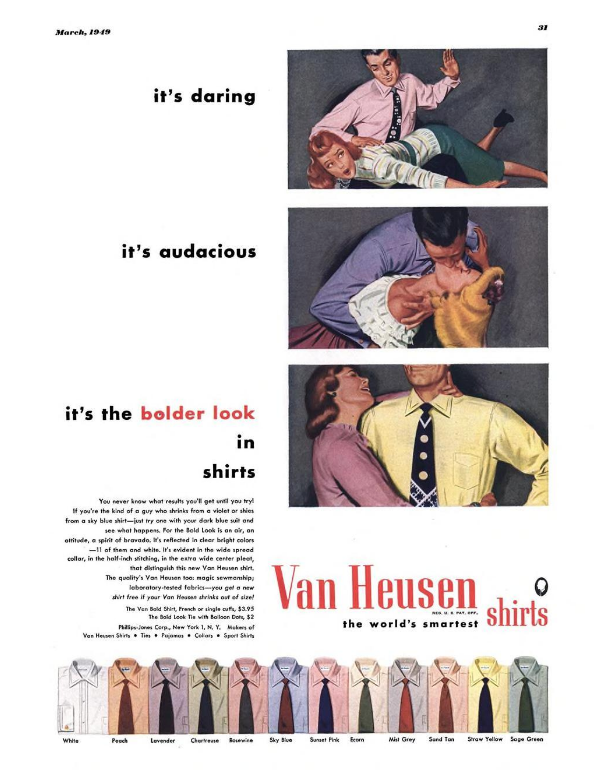
Posted By: Paul - Mon Jan 18, 2021 -
Comments (3)
Category: Antisocial Activities, Fashion, Public Humiliation, Fetishes, 1940s, Men, Women
The Balance Watch
In 2005, John Paul Castro of Santa Monica, CA was granted a patent (No. 6,840,665) for what he called the "Balance Watch". From his patent:
Based on the quality of the artwork in his patent, it's apparent he chose not to splurge and hire a professional illustrator.
As far as I know, the balance watch never made it to market. But it would seem easy enough to make your own. Get two identical watches. Remove the minute hand from one, and the hour hand from the other. Then wear them simultaneously on opposite wrists.
Posted By: Alex - Sun Jan 17, 2021 -
Comments (3)
Category: Fashion, Inventions, Patents, Technology
Mini skirts for road safety
1970: Liverpool officer Lionel Piper urged young women to wear mini skirts. In the interests of road safety. Sure, that was it... road safety!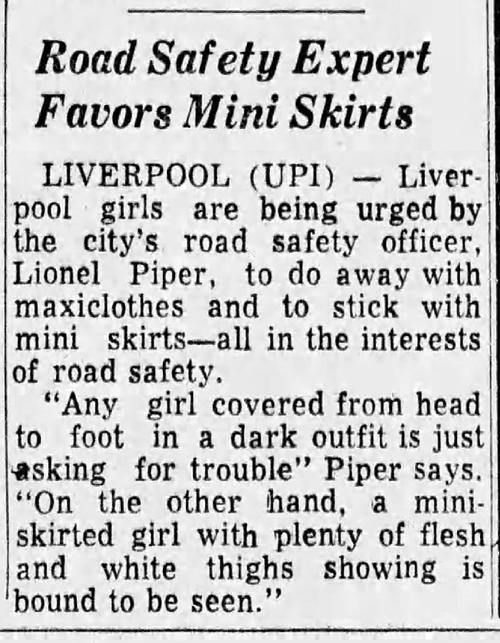
The Hackensack Record - Jan 14, 1970
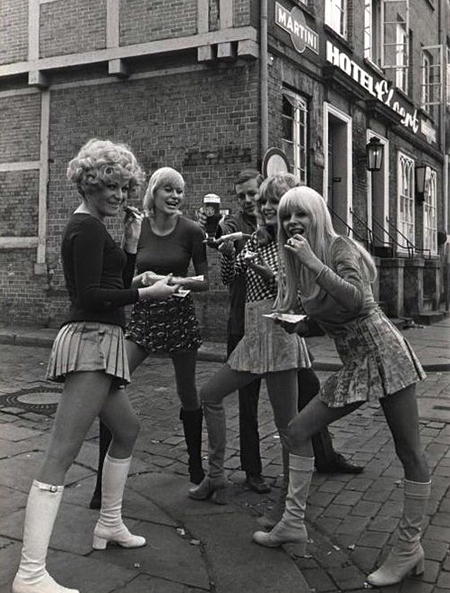
Young women in the 1970s dressed for road safety
Posted By: Alex - Mon Oct 26, 2020 -
Comments (3)
Category: Fashion, Highways, Roads, Streets and Traffic, 1970s
Glue-On Sweat Diverter
Rosecroft Components recently (Dec 2019) was granted a patent for a glue-on "sweat diverter". From their patent:Described herein are sweat-diverting devices which may be affixed to a wearer by an adhesive, such as a pressure-sensitive adhesive...
A sweat-diverting device may be reusable, with an adhesive reapplied for each wearing, or may be single use and disposable, with the adhesive integrated with the device during manufacturing.




Posted By: Alex - Sun Oct 25, 2020 -
Comments (1)
Category: Fashion, Headgear, Inventions, Patents, Body Fluids

| Who We Are |
|---|
| Alex Boese Alex is the creator and curator of the Museum of Hoaxes. He's also the author of various weird, non-fiction, science-themed books such as Elephants on Acid and Psychedelic Apes. Paul Di Filippo Paul has been paid to put weird ideas into fictional form for over thirty years, in his career as a noted science fiction writer. He has recently begun blogging on many curious topics with three fellow writers at The Inferior 4+1. Contact Us |




